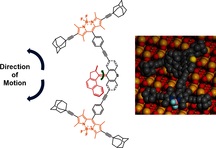Oct 1 2015
New generation of nanocar includes a motor and an easier way to track its movement.

Constructing nanomachines that move controllably across surfaces has the potential to enable researchers to build structures on the nanoscale from the bottom up, but is challenging on several fronts. How such a device can be "powered" so that it moves across a surface without sticking to it and how its movement can then be tracked are questions tackled by the group of James M. Tour in their latest report about the design of a new nanocar in Asian Journal of Organic Chemistry.
The nanocar was built by at Rice University, Houston, Texas, and has a rotary motor, which provides "power" for the vehicle through light-induced isomerization. The isomerization causes the "motor" component to flip its chemical configuration and propels the nanocar with a "paddle-wheel"-type motion. The second important feature is a fluorophore based on 4,4-difluoro-4-bora-3a,4a-diaza-s-indacene (BODIPY), which allows the movement of the nanocar to be tracked by single-molecule fluorescence microscopy while not interfering with the motion of the car on the surface or the function of the motor.
Construction of the nanocar is now complete and Tour says of the work: "We are now at a stage where we can begin the tracking experiments in these motorized nanocars!". The team is presently testing how the cars move on glass surfaces, which they expect to be in circles, and how the tracking system performs.
Authors: Víctor García-López, Pin-Lei E. Chu, Pinn-Tsong Chiang, Jiuzhi Sun, Angel A. Martí, and James M. Tour (http://www.jmtour.com/)
Title: Synthesis of a Light-Driven Motorized Nanocar
Asian Journal of Organic Chemistry
Permalink to the original article: http://dx.doi.org/10.1002/ajoc.201500325 – Please use in your news piece to make sure altmetric.com picks it up and a link to your piece is shown on the journal's website.
Copy free of charge. We would appreciate a transcript of your article or a reference to it.
Contact: Editorial office: [email protected]